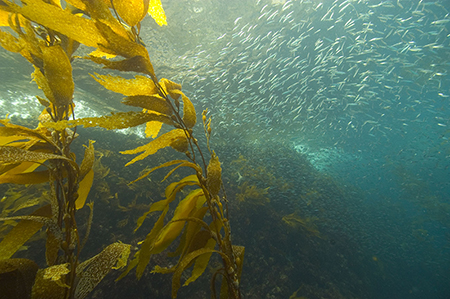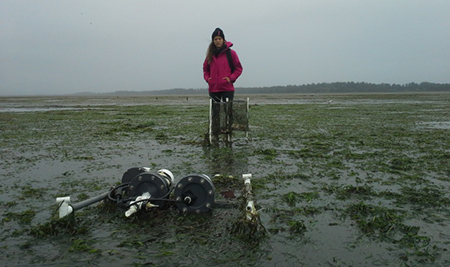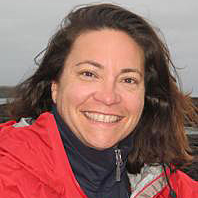In the popular press we have seen several articles about ocean acidification adversely affecting the growth of clams and some species of oyster. This article from a Yale Environmental blog does a wonderful job laying out the challenge and two solutions: eel grass that can process CO2 in the water and placing oyster shell. We have been recycling shell at the Mass Oyster Project for over a decade. Oyster shell was once a major part of our estuarine ecosystems. By returning it through recycling or oyster restoration, we are bringing that balance back.
How Growing Sea Plants Can Help Slow Ocean Acidification
Researchers are finding that kelp, eelgrass, and other vegetation can effectively absorb CO2 and reduce acidity in the ocean. Growing these plants in local waters, scientists say, could help mitigate the damaging impacts of acidification on marine life.

Robert Schwemmer/NOAA
Harvesting kelp, shown here off the California coast, removes CO2 from the ecosystem.
Oregon’s picturesque Netarts Bay has long been known for its oysters. But Netarts, like the whole west coast of North America, is getting more acidic. And the oysters don’t like it.
Since the Industrial Revolution, carbon dioxide in the air has seeped into ocean waters and boosted acidity by 30 percent. Globally, the oceans’ pH has dropped from 8.2 to 8.1, and could drop another 0.4 units by the end of the century. The problem is worse off the west coast of North America, where acidic bottom-waters are brought up to the surface by onshore winds. Corrosive waters like those suck up the building blocks for shells, and can literally eat away at the skeletons of corals.
Last summer, Oregon State University marine ecologist George Waldbusser and his team boated around Netarts Bay planting baby oysters to see how they would fare. The only ones that thrived were those protected by beds of eelgrass, which seemed to swallow up enough carbon dioxide during the peak of each day to give the oysters a break from acid and a window of opportunity for growth.
“Basically nothing outside of those beds survived,” says Waldbusser, who hasn’t yet published the work. Meanwhile, the Whiskey Creek Shellfish Hatchery in Netarts Bay has started only pulling water into their tanks in the afternoon, when photosynthesis peaks and the water is less acidic.
Waldbusser is part of a small team of scientists now exploring the idea that seagrasses, kelps, and shell beds might be able to counteract the rising tide of ocean acidity in local hot spots, making life a little easier for struggling animals. He and other experts on the West Coast Ocean Acidification and Hypoxia Science Panel, which released its first report this April, recommended that scientists and managers push forward such strategies to suck CO2 out of the water.
The idea is a smaller, gentler cousin to grander schemes of geo-engineering. There have been proposals to soak up the ocean’s excess acid by throwing iron, limestone, or olivine into the water, boosting plankton growth, adding the building blocks for shells, or chemically absorbing CO2. But the general response to such plans usually ranges from head-shaking disbelief that they might be feasible or effective, to widespread concern about the possible ecological side effects. The energy needed to mine and distribute rocks, and the unpredictable shift in food webs, have made these schemes unappealing on a global scale.
One study said seagrass meadows should give corals about an 18 percent boost in growth.
On the local scale, however, lower-cost, lower-risk ecological restoration might have the dual benefit of giving threatened sea creatures both a better place to live and a refuge from ocean acid.
Oysters would not be the only creatures to benefit. Derek Manzello manages a long-term ocean acidification monitoring site at Cheeca Rocks in the Florida Keys, as part of the National Oceanic and Atmospheric Administration’s (NOAA) National Coral Reef Monitoring Program. That particular patch of coral is one of the only reefs in the Florida Keys that is still growing; in other reefs, most corals have died from disease and bleaching since the early 1980s. This is odd because Cheeca Rocks, like other near-shore spots in Florida, sees high temperature swings and large amounts of soil and nutrients dumped into the water, which should limit coral growth. There are several possible explanations for Cheeca Rocks’ resistance to these problematic conditions, including that the corals there might be genetically adapted to thrive in harsh conditions. But another possible explanation is that they are living in a low-acidity refuge created by nearby seagrass beds.
In 2012, Manzello showed that Florida’s inshore waters, including where Cheeca Rocks sits, are packed with dissolved aragonite, the material that corals need to grow. Acids in the water decrease the aragonite saturation value; if it gets below 1, corals and shells start to dissolve. In pre-industrial times, these inshore waters typically had a saturation value of 4.6. Today, most reefs in Florida and the Caribbean have been eked down to 3.8. But Florida’s inshore waters have a happy 4.7.
“This is a huge difference,” says Manzello. The reason is the banks of seagrass growing in Florida’s inshore waters, like turtle grass and manatee grass, that suck up CO2 as they photosynthesize — particularly in the spring.
Another study out that same year showed the same effect in the tropical Indo-Pacific. Seagrass meadows there have the potential to increase aragonite saturation by up to 2.9 units, and the pH by 0.38. That should give corals about an 18 percent boost in growth, making seagrass a potential tool for marine park managers, the authors write.

George Waldbusser/OSU
Stephanie Smith stands in a bed of Zostera marina seagrass in Netarts Bay with the CO2 sensor she designed while a graduate student at Oregon State University.
The potential is huge. Plants in the ocean, from seagrasses to plankton, add up to just 0.05 percent of the plant biomass on land, but are so pervasive and efficient at sucking up carbon that they cycle through roughly the same amount of carbon every day as all the land-based plants. Yet seagrass ecosystems are being wiped out, thanks to everything from pandemic disease to water pollution and coastal construction projects. The rate of loss has skyrocketed from less than 1 percent of global seagrass cover per year in the 1970s to 7 percent annually in the 2000s, making seagrasses one of the planet’s most threatened ecosystems. Efforts to restore or farm such plants could have a host of benefits, including soaking up atmospheric carbon.
Waldbusser cautions that many scientists don’t yet know about the effect of seagrasses on ocean chemistry. Some breeds, like the invasive Zostera japonicaeelgrass in Oregon, tend to shed their leaves in the winter, and the degrading plant matter boosts carbon dioxide levels in the water rather than lowering them. And if the water is swift flowing, then any patches of water made less acidic by plants will likely be swept away before they have a chance to benefit local shellfish or corals.
Seagrasses aren’t the only possible solution. Kelp is also well known for soaking up excess nutrients and making waters cleaner for shellfish. Most academic papers looking at the benefits of kelp don’t even mention acidification. But it didn’t take much for Nichole Price of the Bigelow Laboratory for Ocean Science in Maine to put two and two together. “The biggest challenge in land-based kelp nurseries is keeping the pH low enough because they consume so much CO2,” says Price, who wondered how those same photosynthetic algae were affecting ocean waters.
Price teamed up with Ocean Approved, North America’s first commercial kelp farmer, to put instruments inside and outside of its kelp farms to see what was going on. In as-yet-unpublished work, they show that the aragonite saturation level is half a unit to a full unit higher within the kelp farm. “That’s bigger than the change we expect from ocean acidification,” she says. Next year they plan to map the extent of the impact, and test the effect of the kelp on a mussel farm around the corner. That farm, says Price, has already started growing kelp based on these preliminary results.
Researchers will soon start the first large-scale project to plant and grow kelp to suck up CO2.
The key, says Price, is to harvest the kelp so that the carbon it extracts gets removed from the ecosystem. It’s hard to compete with Asian kelp suppliers, but local kelp could be dried and used as food or fertilizer, adding a layer of economic diversity to a struggling coastal economy. “There’s a lot of potential for shellfish aquaculture, but people are really hesitant [because of acidification],” says Price, who now heads up Bigelow’s Centers for Venture Research. Pairing up with seaweeds might be the trick to buy new businesses a bit of insurance against future conditions, she says.
This autumn, researchers will start the first large-scale project to intentionally plant and grow kelp to suck up carbon dioxide. The Puget Sound Restoration Fund, based in Bainbridge Island, Washington, won $1.5 million from the Paul G. Allen Ocean Challenge in April 2015 to investigate the potential for sugar kelp to reduce acidity in local waters, where the pH can hit 7.8. Plans call for starting farming an acre of kelp this October.
Ocean waters can be buffered against acids by non-living material, too. Instead of soaking up carbon dioxide, the strategy here is to add more carbonate to the water. That shifts the aragonite saturation point and, again, makes it easier for shells to grow.
Nearly every estuary that once had a thriving oyster industry hosts an effort to put old shells back into the water, says Waldbusser. Most, if not all, of these projects are focused on giving the oysters or other shellfish something to grow on — their babies prefer to sit on piles of old shells, rather than getting buried or choked by mud. The fact that these shells help to buffer water acidity is an added bonus.
The Chesapeake Bay, he notes, has seen the largest oyster reef restoration effort to date and also possibly the largest (and unintentional) ocean acidification buffering experiment. About 196 million bushels of dredged oyster shells were put back into Chesapeake Bay from 1960 until 2006, before the project coordinators ran low on shells. They’re still about 100 million bushels short of where the Chesapeake’s ecology would have been had oysters not been extracted for centuries, notes Waldbusser, and the effects on the bay’s complex water chemistry have so far been hard to track. But that doesn’t mean that shells can’t shift pH significantly under different conditions.
In previous work off the coast of Maine, Waldbusser’s team, led by Mark Green of Saint Joseph’s College of Maine, mixed old ground-up shells with ocean sediments and replanted them. They then looked to see how that affected oysters. Three times as many oyster larvae settled in the shell-rich soils as in the non-shelled soils, they found. The reason, Waldbusser thinks, is because of a change in water acidity within the pores of the sediment.
ALSO FROM YALE e360Examining How Marine Life Might Adapt to Acidified Oceans

“You have this incredibly hostile environment in the pore water, which is generally more acidic than the overlying water,” says Waldbusser. “Mix shell in and it’s a little less hostile.”
Waldbusser is familiar with other proposed ways of shifting ocean pH. He wrote a proposal to use the waste CO2 emitted from a hatchery to dissolve calcium carbonate rocks and bubble the products back into the ocean, helping to buffer acidity in much the same way as is done in home aquariums. But it didn’t get funded. “There are lots of technologies that exist and things you can do, but it comes back to scalability and unintended consequences,” says Waldbusser. Using rocks to buffer ocean water, for example, involves using energy to treat the minerals beforehand so they dissolve, and then you have to worry about toxic levels of nickel or cadmium hitching a ride along with the rocks.
In the end, says Waldbusser, “I always come back to restoration.” Replanting the seagrasses or shell banks that used to exist in an estuary is much safer, and often easier, than some industrial schemes. And, he adds, it probably comes with “built-in benefits that we don’t even recognize.”
